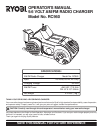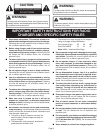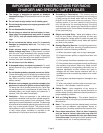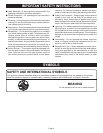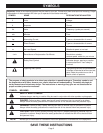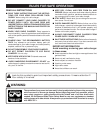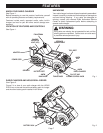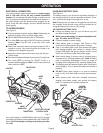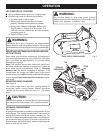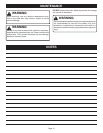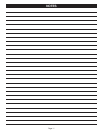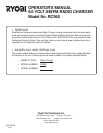
Page 3
■ The charger is designed to operate on standard
household voltage. Do not attempt to use it on any other
voltage.
■ Do not insert foreign matter into the battery port.
■ Do not charge by means of an engine generator or DC
power source.
■ Do not disassemble the battery.
■ Do not charge or store the tool and battery in loca-
tions where the temperature may reach or exceed
100
°F (38°C), such as outside sheds or metal build-
ings.
■ Do not incinerate the battery, even if it is severely
damaged or completely worn out. The battery may
explode in fire.
■ Under extreme usage or temperature conditions,
battery leakage may occur. If liquid comes in contact
with your skin, wash immediately with soap and water,
then neutralize with lemon juice or vinegar. If liquid gets
in your eyes, flush them with clean water for at least 10
minutes, then seek immediate medical attention.
■ Do not short-circuit the battery.
■ A damaged battery is subject to explosion. To avoid
serious personal injury, properly dispose of a damaged
battery.
■ Do not discharge battery beyond normal use limits.
Further discharging (such as by placing a rubber band on
the trigger switch) can cause a deep discharge which
may result in polarity reversal of a cell, rendering the
battery useless.
■ Batteries vent hydrogen gas and can explode in the
presence of a source of ignition, such as a pilot light.
To reduce the risk of serious personal injury, never use
any cordless product in the presence of open flame. An
exploded battery can propel debris and chemicals. If
exposed, flush with water immediately.
■ Ventilation – Slots and openings in the cabinet are
provided for ventilation and to ensure reliable operation
of the product and to protect it from overheating. These
openings must not be blocked or covered. The openings
should never be blocked by placing the product on a bed,
sofa, rug, or other similar surface. This product should
not be placed in a built-in installation such as a bookcase
or rack unless proper ventilation is provided or the
manufacturer's instructions have been adhered to.
IMPORTANT SAFETY INSTRUCTIONS FOR RADIO
CHARGER AND SPECIFIC SAFETY RULES
■ Grounding or Polarization – This product may be
equipped with a polarized alternating-current line plug
(a plug having one blade wider than the other). This
plug will fit into the power outlet only one way. This is
a safety feature. If you are unable to insert the plug
fully into the outlet, try reversing the plug. If the plug
should still fail to fit, contact your electrician to replace
your obsolete outlet. Do not defeat the safety purpose
of the polarized plug.
■ Object and Liquid Entry – Never push objects of any
kind into this product through openings as they may
touch dangerous voltage points or short-out parts that
could result in a fire or electric shock. Never spill liquid of
any kind on the product.
■ Damage Requiring Service – Unplug this product from
the wall outlet and refer servicing to qualified service
personnel under the following conditions:
A) When the power-supply cord or plug is damaged,
B) If liquid has been spilled, or objects have fallen into
the product,
C) If the product has been exposed to rain or water,
D) If the product does not operate normally by following
the operating instructions. Adjust only those controls
that are covered by the operating instructions as an
improper adjustment of other controls may result in
damage and will often require extensive work by a
qualified technician to restore the product to its normal
operation,
E) If the product has been dropped or damaged in any
way, and
F) When the product exhibits a distinct change in per-
formance – this indicates a need for service.
■ Safety Check – Upon completion of any service or
repairs to this product, ask the service technician to
perform safety checks to determine that the product is in
proper operating condition.
■ Wall or Ceiling Mounting – This product should be
mounted to a wall or ceiling only as recommended by the
Manufacturer.
■ Heat – The product should be situated away from heat
sources such as radiators, heat registers, stoves, or
other products (including amplifiers) that produce heat.
■ Save these instructions. Refer to them frequently
and use them to instruct others who may use this
tool. If you loan someone this tool, loan them these
instructions also. Following this rule will reduce the risk
of electric shock, fire, or serious personal injury.



